Phytochemical Composition and Biological Activity of the Essential Oil from Ericameria nauseosa Collected in Southwestern Montana, United States
Abstract
:1. Introduction
2. Results and Discussion
2.1. Composition of Essential Oil from E. nauseosa
2.2. Effect of E. nauseosa Essential Oil on Neutrophil Ca2+ Influx and Chemotaxis
3. Materials and Methods
3.1. Plant Material
3.2. Chemicals and Reagents
3.3. Essential Oil Distillation
3.4. Gas Chromatography–Flame Ionization Detector (GC-FID) and Gas Chromatography–Mass Spectrometry (GC-MS) Analysis
3.5. Isolation of Human Neutrophils
3.6. Ca2+ Mobilization Assay
3.7. Chemotaxis Assay
3.8. Cytotoxicity Assay
3.9. Statistical Analysis
4. Conclusions
Supplementary Materials
Author Contributions
Funding
Data Availability Statement
Conflicts of Interest
References
- Mandel, J.R.; Dikow, R.B.; Siniscalchi, C.M.; Thapa, R.; Watson, L.E.; Funk, V.A. A fully resolved backbone phylogeny reveals numerous dispersals and explosive diversifications throughout the history of Asteraceae. Proc. Natl. Acad. Sci. USA 2019, 116, 14083–14088. [Google Scholar] [CrossRef]
- Bremer, K.; Jansen, R.K.; Karis, P.O.; Källersjö, M.; Keeley, S.C.; Kim, K.J.; Michaels, H.J.; Palmer, J.D.; Wallace, R.S. A review of the phylogeny and classification of the Asteraceae. Nord. J. Bot. 1992, 12, 141–148. [Google Scholar] [CrossRef]
- Roberts, R.P.; Urbatsch, L.E. Molecular phylogeny of Ericameria (Asteraceae, Astereae) based on nuclear ribosomal 3′ ETS and ITS sequence data. Taxon 2003, 52, 209–228. [Google Scholar]
- Anderson, L.C. Unique Chrysothamnus hybridizations in Ash Meadows, Nevada. Bull. Torrey Bot. Club 1973, 100, 171–177. [Google Scholar] [CrossRef]
- Hall, H.M. The Genus Haplopappus—A Phylogenetic Study in the Compositae; Carnegie Institution of Washington: Washington, DC, USA, 1928; pp. 1–391. [Google Scholar]
- Nesom, G.L. Taxonomic summary of Ericameria (Asteraceae, Astereae), with the inclusion of Haplopappus sects. Macronema and Asiris. Phytologia 1990, 68, 144–155. [Google Scholar] [CrossRef]
- Reveal, J.L. Proposal to conserve the name Chrysocoma nauseosa (Chrysothamnus nauseosus, Ericameria nauseosa) with a conserved type (Asteraceae). Taxon 2008, 57, 305–306. [Google Scholar]
- Anderson, L.C. The Chrysothamnus-Ericameria connection (Asteraceae). Great Basin Nat. 1995, 55, 84–88. [Google Scholar]
- Rose, A.F. Grindelane diterpenoids from Chrysothamnus nauseosus. Phytochemistry 1980, 19, 2689–2693. [Google Scholar] [CrossRef]
- Bohlmann, F.; Dutta, L.; Robinson, H.; King, R.M. Neue labdan-derivate aus Chrysothamnus nauseusus. Phytochemistry 1979, 18, 1889–1892. [Google Scholar] [CrossRef]
- Hell, T.; Dobrzyński, M.; Gröflin, F.; Reinhardt, J.K.; Dürr, L.; Pertz, O.; Hamburger, M.; Garo, E. Flavonoids from Ericameria nauseosa inhibiting PI3K/AKT pathway in human melanoma cells. Biomed. Pharm. 2022, 156, 113754. [Google Scholar] [CrossRef] [PubMed]
- Ahmed, A.A.; Hegazy, M.-E.F.; Hassan, N.M.; Wojcinska, M.; Karchesy, J.; Pare, P.W.; Mabry, T.J. Constituents of Chrysothamnus viscidiflorus. Phytochemistry 2006, 67, 1547–1553. [Google Scholar] [CrossRef]
- Hegazy, M.-E.F.; Mohamed, A.E.-H.H.; El-Razek, M.H.A.; Hammouda, F.M.; Hassan, N.M.; Mahalel, U.A.; El-Halawany, A.M.; Mahmoud, A.A.; Karchesy, J.; Hirata, T. Genus Chrysothamnus: A source of bioactive compounds. Nat. Prod. Commun. 2007, 2, 951–957. [Google Scholar] [CrossRef]
- Rose, A.F.; Butt, B.; Jermy, T. Polyacetylenes from the rabbitbrush, Chrysothamnus nauseosus. Phytochemistry 1980, 19, 563–566. [Google Scholar] [CrossRef]
- Hegerhorst, D.; Weber, D.; McArthur, E.; Khan, A. Chemical analysis and comparison of subspecies of Chrysothamnus nauseosus and other related species. Biochem. Syst. Ecol. 1987, 15, 201–208. [Google Scholar] [CrossRef]
- Moerman, D.E. Native American Medicinal Plants: An Ethnobotanical Dictionary; Timber Press: Portland, OR, USA, 2009; p. 139. [Google Scholar]
- Hart, J.A. The ethnobotany of the Northern Cheyenne Indians of Montana. J. Ethnopharmacol. 1981, 4, 1–55. [Google Scholar] [CrossRef]
- Train, P.; Henrichs, J.R.; Archer, W.A. Medicinal Uses of Plants by Indian Tribes of Nevada. In US Department of Agriculture; Division of Plant Exploration and Introduction, Bureau of Plant Industry, U.S. Department of Agriculture: Washington, DC, USA, 1957; p. 57. [Google Scholar]
- Childress, D.; Sanchez, S.; French, V.; Terry, T.J. Isolation, separation, and identification of antimicrobial compounds from Ericameria nauseosa. N. M. J. Sci. 2018, 52, 45–46. [Google Scholar]
- Acharya, J.; Hildreth, M.B.; Reese, R.N. In vitro screening of forty medicinal plant extracts from the United States Northern Great Plains for anthelmintic activity against Haemonchus contortus. Vet. Parasitol. 2014, 201, 75–81. [Google Scholar] [CrossRef]
- Valdivieso-Ugarte, M.; Gomez-Llorente, C.; Plaza-Díaz, J.; Gil, Á. Antimicrobial, antioxidant, and immunomodulatory properties of essential oils: A systematic review. Nutrients 2019, 11, 2786. [Google Scholar] [CrossRef] [PubMed]
- Sandner, G.; Heckmann, M.; Weghuber, J. Immunomodulatory activities of selected essential oils. Biomolecules 2020, 10, 1139. [Google Scholar] [CrossRef] [PubMed]
- Gandhi, G.R.; Vasconcelos, A.B.S.; Haran, G.H.; Calisto, V.; Jothi, G.; Quintans, J.S.S.; Cuevas, L.E.; Narain, N.; Júnior, L.J.Q.; Cipolotti, R.; et al. Essential oils and its bioactive compounds modulating cytokines: A systematic review on anti-asthmatic and immunomodulatory properties. Phytomedicine 2020, 73, 152854. [Google Scholar] [CrossRef]
- Dosoky, N.S.; Kirpotina, L.N.; Schepetkin, I.A.; Khlebnikov, A.I.; Lisonbee, B.L.; Black, J.L.; Woolf, H.; Thurgood, T.L.; Graf, B.L.; Satyal, P.; et al. Volatile composition, antimicrobial activity, and in vitro innate immunomodulatory activity of Echinacea purpurea (L.) Moench essential oils. Molecules 2023, 28, 7330. [Google Scholar] [CrossRef]
- Tabanca, N.; Demirci, B.; Crockett, S.L.; Başer, K.H.C.; Wedge, D.E. Chemical composition and antifungal activity of Arnica longifolia, Aster hesperius, and Chrysothamnus nauseosus essential oils. J. Agric. Food Chem. 2007, 55, 8430–8435. [Google Scholar] [CrossRef]
- Chao, S.; Young, D.G.; Casabianca, H.; Bertrand, M.-C. Composition of the oils of three Chrysothamnus nauseousus varieties. J. Essent. Oil Res. 2003, 15, 425–427. [Google Scholar] [CrossRef]
- Stirling, J.; Platt, B.G.; Satyal, P.; Swor, K.; Setzer, W.N. The essential oils of rubber rabbitbrush (Ericameria nauseosa) from North-Central Utah and Southwestern Idaho. Nat. Prod. Commun. 2023, 18, 1–12. [Google Scholar] [CrossRef]
- Babushok, V.I.; Linstrom, P.J.; Zenkevich, I.G. Retention indices for frequently reported compounds of plant essential oils. J. Phys. Chem. Ref. Data 2011, 40, 043101. [Google Scholar] [CrossRef]
- Wedge, D.E.; Tabanca, N.; Sampson, B.J.; Werle, C.; Demirci, B.; Baser, K.H.C.; Nan, P.; Duan, J.; Liu, Z. Antifungal and insecticidal activity of two Juniperus essential oils. Nat. Prod. Commun. 2009, 4, 123–127. [Google Scholar] [CrossRef] [PubMed]
- Yang, C.; Luo, L.; Zhang, H.; Yang, X.; Lv, Y.; Song, H. Common aroma-active components of propolis from 23 regions of China. J. Sci. Food Agric. 2010, 90, 1268–1282. [Google Scholar] [CrossRef]
- Piasenzotto, L.; Gracco, L.; Conte, L. Solid phase microextraction (SPME) applied to honey quality control. J. Sci. Food Agric. 2003, 83, 1037–1044. [Google Scholar] [CrossRef]
- Chenni, M.; El Abed, D.; Rakotomanomana, N.; Fernandez, X.; Chemat, F. Comparative study of essential oils extracted from Egyptian basil leaves (Ocimum basilicum L.) using hydro-distillation and solvent-free microwave extraction. Molecules 2016, 21, 113. [Google Scholar] [CrossRef]
- Baser, K.H.C.; Demirci, B.; Kurkcuoglu, M.; Satin, F.; Tumen, G. Comparative morphological and phytochemical charactertization of Salvia cadmica and S. smyrnaea. Pak. J. Bot. 2009, 41, 1545–1555. [Google Scholar]
- Tunalier, Z.; Kirimer, N.; Baser, K.H.C. The composition of essential oils from various parts of Juniperus foetidissima. Chem. Nat. Compd. 2002, 38, 43–47. [Google Scholar] [CrossRef]
- Wedge, D.E.; Klun, J.A.; Tabanca, N.; Demirci, B.; Ozek, T.; Baser, K.H.C.; Liu, Z.; Zhang, S.; Cantrell, C.L.; Zhang, J. Bioactivity-guided fractionation and GC/MS fingerprinting of Angelica sinensis and Angelica archangelica root components for antifungal and mosquito deterrent activity. J. Agric. Food Chem. 2009, 57, 464–470. [Google Scholar] [CrossRef] [PubMed]
- Hazzit, M.; Baaliouamer, A.; Faleiro, M.L.; Miguel, M.G. Composition of the essential oils of Thymus and Origanum species from Algeria and their antioxidant and antimicrobial activities. J. Agric. Food Chem. 2006, 54, 6314–6321. [Google Scholar] [CrossRef] [PubMed]
- Baser, K.H.C.; Özek, T.; Demirci, B.; Kürkcüoglu, M.; Aytac, Z.; Duman, H. Composition of the essential oils of Zosima absinthifolia (Vent.) Link and Ferula elaeochytris Korovin from Turkey. Flavour Fragr. J. 2000, 15, 371–372. [Google Scholar] [CrossRef]
- Suleimen, Y.; Atazhanova, G.; Ozek, T.; Demirci, B.; Kulyyasov, A.T.; Adekenov, S.M.; Baser, K.H.C. Essential oil composition of three species of Achillea from Kazakhstan. Chem. Nat. Compd. 2006, 37, 447–450. [Google Scholar] [CrossRef]
- Schepetkin, I.A.; Özek, G.; Özek, T.; Kirpotina, L.N.; Khlebnikov, A.I.; Quinn, M.T. Chemical composition and immunomodulatory activity of Hypericum perforatum essential oils. Biomolecules 2020, 10, 916. [Google Scholar] [CrossRef] [PubMed]
- Baser, K.H.C.; Özek, T.; Dmirci, B.; Duman, H. Composition of the essential oil of Glaucosciadium cordifolium (Boiss.) Burtt et Davis from Turkey. Flavour Fragr. J. 2000, 15, 45–46. [Google Scholar] [CrossRef]
- Sylvestre, M.; Pichette, A.; Longtin, A.; Nagau, F.; Legault, J. Essential oil analysis and anticancer activity of leaf essential oil of Croton flavens L. from Guadeloupe. J. Ethnopharmacol. 2006, 103, 99–102. [Google Scholar] [CrossRef]
- Lorenzo, D.; Dellacassa, E.; Atti-Serafini, L.; Santos, A.C.; Frizzo, C.; Paroul, N.; Moyna, P.; Mondello, L.; Dugo, G. Composition and stereoanalysis of Cymbopogon winterianus Jowitt oil from Southern Brazil. Flavour Fragr. J. 2000, 15, 177–181. [Google Scholar] [CrossRef]
- Viljoen, A.M.; Subramoney, S.; van Vuuren, S.F.; Baser, K.H.C.; Demirci, B. The composition, geographical variation and antimicrobial activity of Lippia javanica (Verbenaceae) leaf essential oils. J. Ethnopharmacol. 2005, 96, 271–277. [Google Scholar] [CrossRef]
- Göger, G.; Yavaş, I.; Yur, S.; Köse, Y.B.; Özek, G. Volatiles and fatty acid analyzes of Tripleurospermum decipiens (Fisch & C. A. Mey) Bornm and biological activities of the extracts. J. Res. Pharm. 2021, 25, 429–440. [Google Scholar]
- Vernin, G.; Merad, O.; Vernin, G.; Zamkotsian, R.; Parkanyi, C. GC-MS analysis of Artemisia herba alba Asso essential oils from Algeria. Dev. Food Sci. 1995, 37, 147–205. [Google Scholar]
- Adawe, A.M.; Dari, Y.; Uysal, Ü.D.; Özek, T.; Özek, G.; Güray, T. Determination of biological activity of the of Azadiracta indica A. Juss. grown In Somalia. Int. J. Sci. Res. Chem. 2022, 7, 1–14. [Google Scholar]
- Maggio, A.; Riccobono, L.; Spadaro, V.; Scialabba, A.; Bruno, M.; Senatore, F. Chemical composition of the essential oils of three endemic species of Anthemis Sect. Hiorthia (DC.) R. Fern. growing wild in Sicily and chemotaxonomic volatile markers of the genus Anthemis L.: An update. Chem. Biodiver. 2014, 11, 652–672. [Google Scholar] [CrossRef] [PubMed]
- Halls, S.C.; Gang, D.R.; Weber, D.J. Seasonal variation in volatile secondary compounds of Chrysothamnus nauseosus (Pallas) Britt.; Asteraceae ssp. hololeucus (Gray) Hall. & Clem. influences herbivory. J. Chem. Ecol. 1994, 20, 2055–2063. [Google Scholar]
- Jolliffe, I.T.; Cadima, J. Principal component analysis: A review and recent developments. Philos. Trans. A-Math. Phys. Eng. Sci. 2016, 374, 20150202. [Google Scholar] [CrossRef] [PubMed]
- Nauseef, W.M.; Borregaard, N. Neutrophils at work. Nat. Immunol. 2014, 15, 602–611. [Google Scholar] [CrossRef] [PubMed]
- Dixit, N.; Simon, S.I. Chemokines, selectins and intracellular calcium flux: Temporal and spatial cues for leukocyte arrest. Front. Immunol. 2012, 10, 188. [Google Scholar] [CrossRef] [PubMed]
- Ali, H.; Richardson, R.M.; Haribabu, B.; Snyderman, R. Chemoattractant receptor cross-desensitization. J. Biol. Chem. 1999, 274, 6027–6030. [Google Scholar] [CrossRef]
- Schepetkin, I.A.; Ozek, G.; Ozek, T.; Kirpotina, L.N.; Khlebnikov, A.I.; Quinn, M.T. Chemical composition and immunomodulatory activity of essential oils from Rhododendron albiflorum. Molecules 2021, 26, 3652. [Google Scholar] [CrossRef]
- Schepetkin, I.A.; Ozek, G.; Ozek, T.; Kirpotina, L.N.; Khlebnikov, A.I.; Klein, R.A.; Quinn, M.T. Neutrophil immunomodulatory activity of farnesene, a component of Artemisia dracunculus essential oils. Pharmaceuticals 2022, 15, 642. [Google Scholar] [CrossRef]
- Schepetkin, I.A.; Kushnarenko, S.V.; Ozek, G.; Kirpotina, L.N.; Sinharoy, P.; Utegenova, G.A.; Abidkulova, K.T.; Ozek, T.; Baser, K.H.; Kovrizhina, A.R.; et al. Modulation of human neutrophil responses by the essential oils from Ferula akitschkensis and their constituents. J. Agric. Food Chem. 2016, 64, 7156–7170. [Google Scholar] [CrossRef]
- Schepetkin, I.A.; Kushnarenko, S.V.; Ozek, G.; Kirpotina, L.N.; Utegenova, G.A.; Kotukhov, Y.A.; Danilova, A.N.; Ozek, T.; Baser, K.H.; Quinn, M.T. Inhibition of human neutrophil responses by the essential oil of Artemisia kotuchovii and its constituents. J. Agric. Food Chem. 2015, 63, 4999–5007. [Google Scholar] [CrossRef]
- Schepetkin, I.A.; Ozek, G.; Ozek, T.; Kirpotina, L.N.; Kokorina, P.I.; Khlebnikov, A.I.; Quinn, M.T. Neutrophil immunomodulatory activity of nerolidol, a major component of essential oils from Populus balsamifera Buds and propolis. Plants 2022, 11, 3399. [Google Scholar] [CrossRef]
- Xie, Q.; Wang, C. Polyacetylenes in herbal medicine: A comprehensive review of its occurrence, pharmacology, toxicology, and pharmacokinetics (2014–2021). Phytochemistry 2022, 201, 113288. [Google Scholar] [CrossRef]
- Wang, Q.H.; Hao, J.S.; Gong, J.H.; Bao, W.Q. Isolation and structure elucidation of two new compounds from Artemisia ordosica krasch. Nat. Prod. Res. 2020, 34, 1862–1867. [Google Scholar] [CrossRef]
- Kato-Noguchi, H.; Kato, M. Allelopathy and Allelochemicals of Solidago canadensis L. and S. altissima L. for Their Naturalization. Plants 2022, 11, 3235. [Google Scholar] [CrossRef]
- Ismail, M.; Kowsar, A.; Javed, S.; Choudhary, M.I.; Khan, S.W.; Abbas, Q.; Tang, Y.R.; Wang, W. The antibacterial, insecticidal and nematocidal activities and toxicity studies of Tanacetum falconeri Hook. f. Turk. J. Pharm. Sci. 2021, 18, 744–751. [Google Scholar] [CrossRef]
- Garrais, S.; Turkington, J.; Goldring, W.P. Synthesis of isomeric polyacetylenes based on natural hydroxy matricaria esters. Tetrahedron 2009, 65, 8418–8427. [Google Scholar] [CrossRef]
- Chen, Z.H.; Su, Y.X.; Ding, J.T.; He, J.; Lai, L.H.; Song, Y.J. Lobetyolin protects mice against LPS-induced sepsis by downregulating the production of inflammatory cytokines in macrophage. Front. Pharmacol. 2024, 15, 1405163. [Google Scholar] [CrossRef]
- Liu, C.X.; Zhou, M.Z.; Jiang, W.J.; Ye, S.M.; Tian, S.; Jiang, C.; Hao, K.; Li, H.Q.; Hu, Q.H. GPR105-targeted therapy promotes gout resolution as a switch between NETosis and apoptosis of neutrophils. Front. Immunol. 2022, 13, 870183. [Google Scholar] [CrossRef]
- Matsuda, H.; Murakami, T.; Kageura, T.; Ninomiya, K.; Toguchida, I.; Nishida, N.; Yoshikawa, M. Hepatoprotective and nitric oxide production inhibitory activities of coumarin and polyacetylene constituents from the roots of Angelica furcijuga. Bioorg. Med. Chem. Lett. 1998, 8, 2191–2196. [Google Scholar] [CrossRef]
- Li, M.; Zeng, M.N.; Zhang, J.K.; Shi, J.Y.; Lv, J.J.; Tang, Y.Y.; Zheng, X.K.; Feng, W.S. Anti-inflammatory Dendranacetylene A, a new polyacetylene glucoside from the flower of Chrysanthemum morifolium Ramat. Nat. Prod. Res. 2021, 35, 5692–5698. [Google Scholar] [CrossRef]
- Kobayashi, M.; Mahmud, T.; Tajima, H.; Wang, W.Q.; Aoki, S.; Nakagawa, S.; Mayumi, T.; Kitagawa, I. Marine natural products. XXXVI. Biologically active polyacetylenes, adociacetylenes A, B, C, and D, from an Okinawan marine sponge of Adocia sp. Chem. Pharmaceut. Bull. 1996, 44, 720–724. [Google Scholar] [CrossRef]
- Schepetkin, I.A.; Özek, G.; Özek, T.; Kirpotina, L.N.; Khlebnikov, A.I.; Quinn, M.T. Neutrophil immunomodulatory activity of (−)-borneol, a major component of essential oils extracted from Grindelia squarrosa. Molecules 2022, 27, 4897. [Google Scholar] [CrossRef] [PubMed]
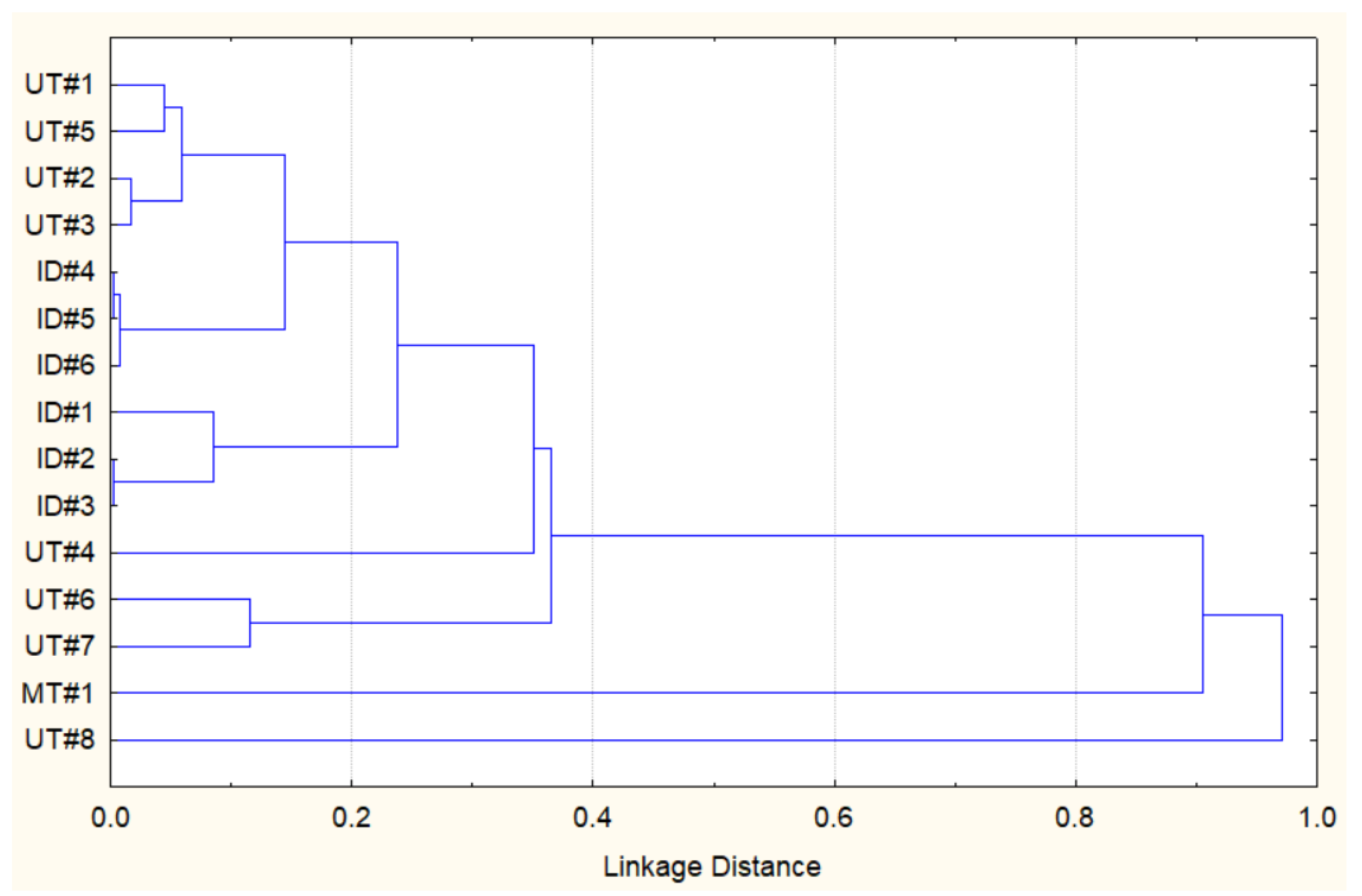

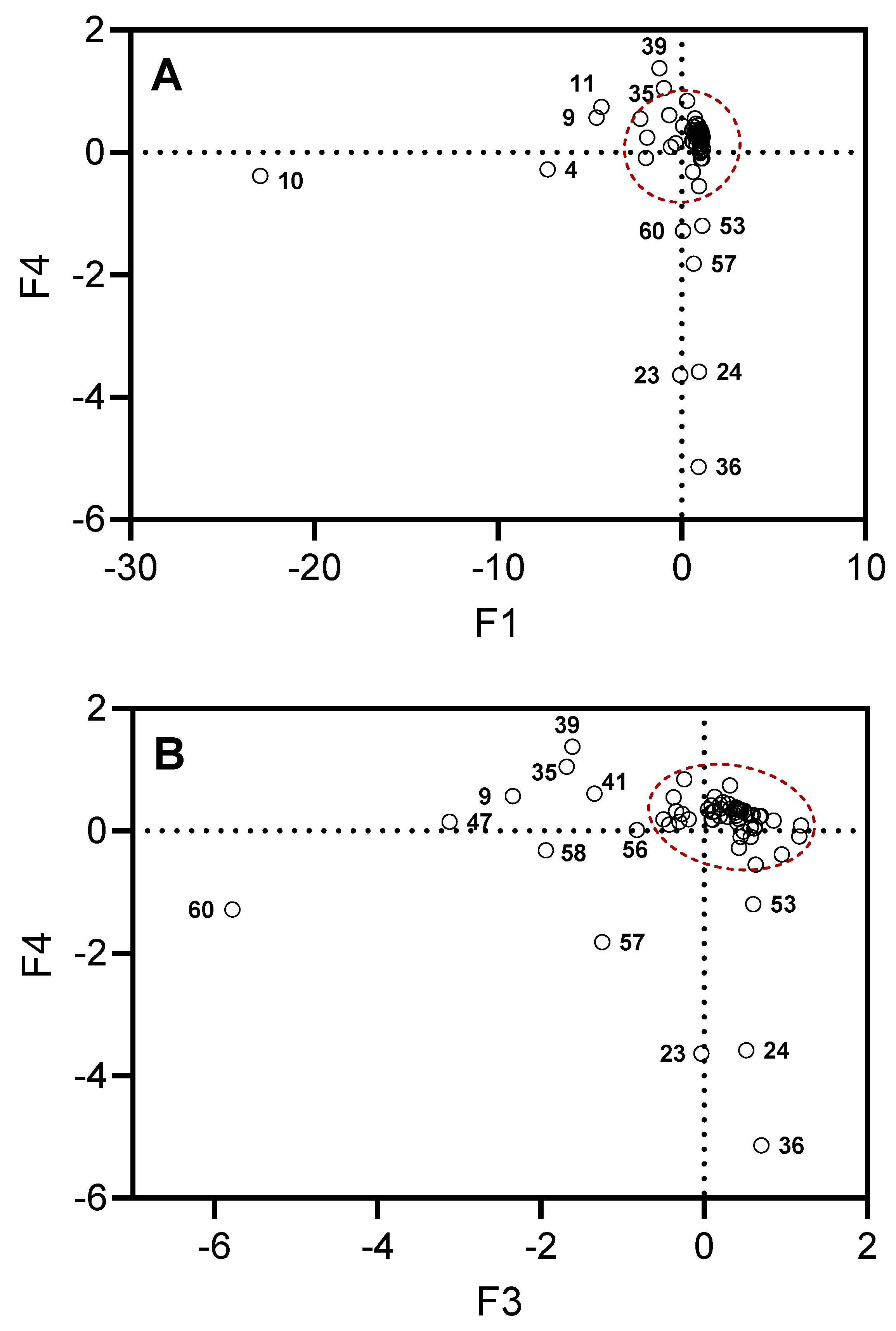
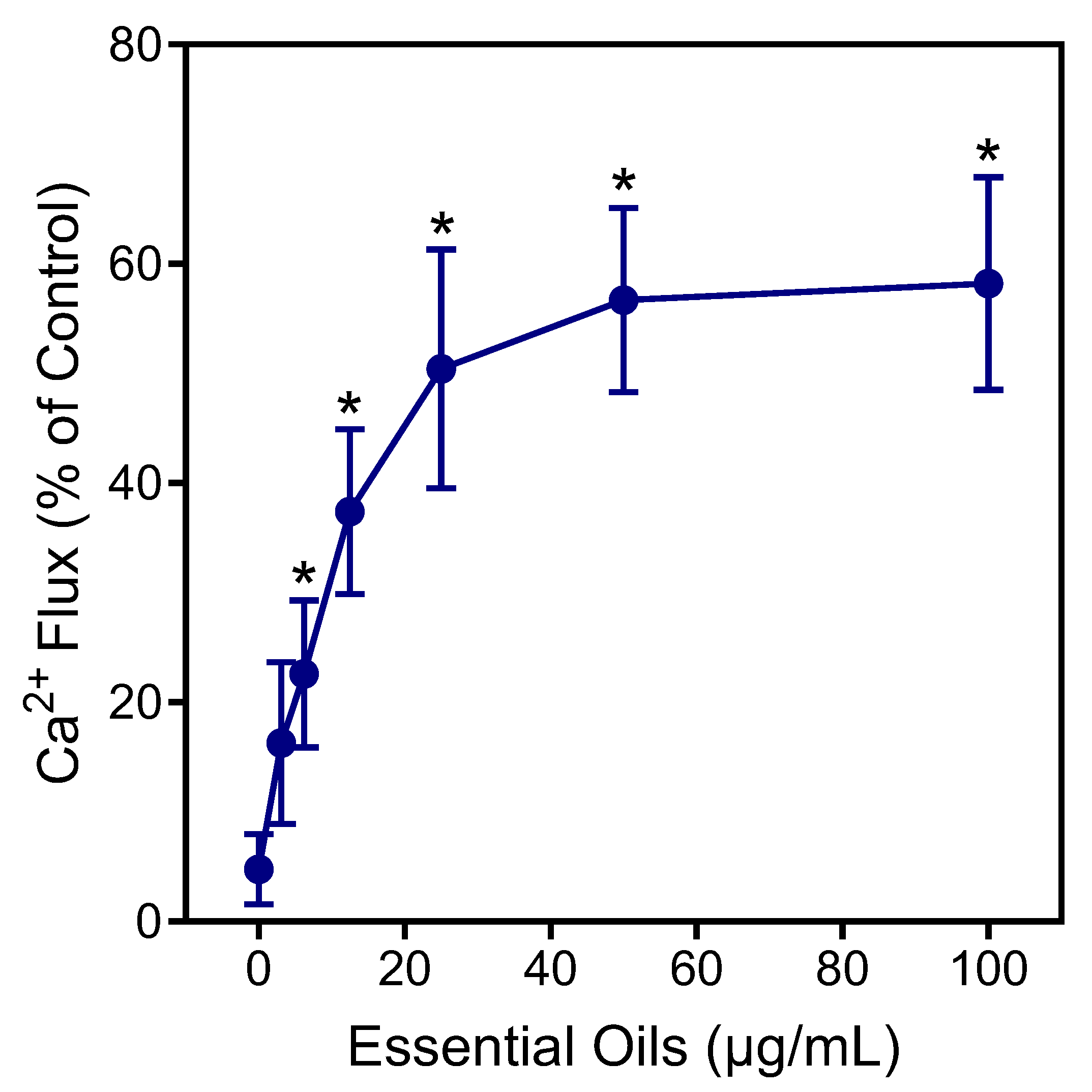
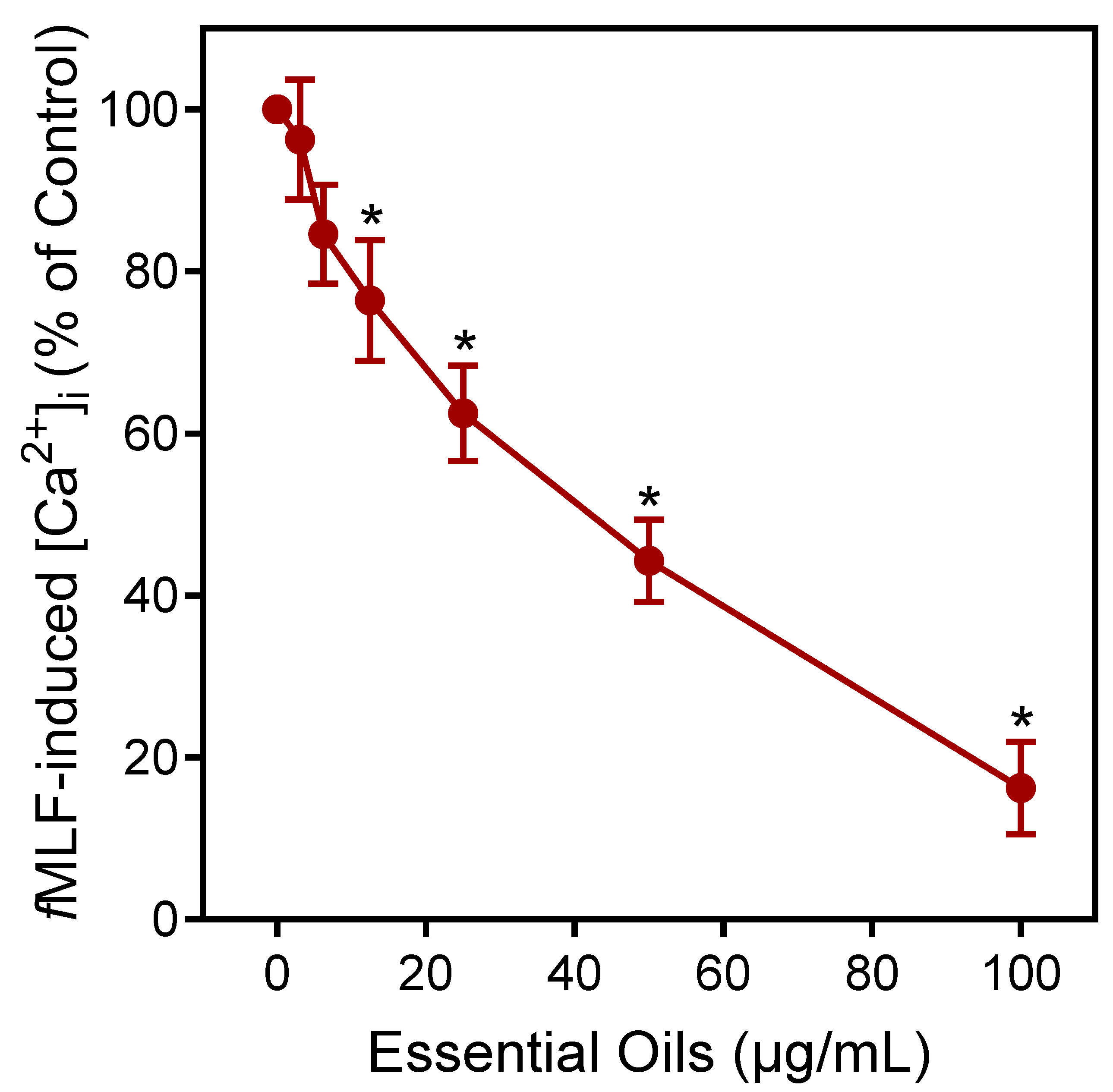

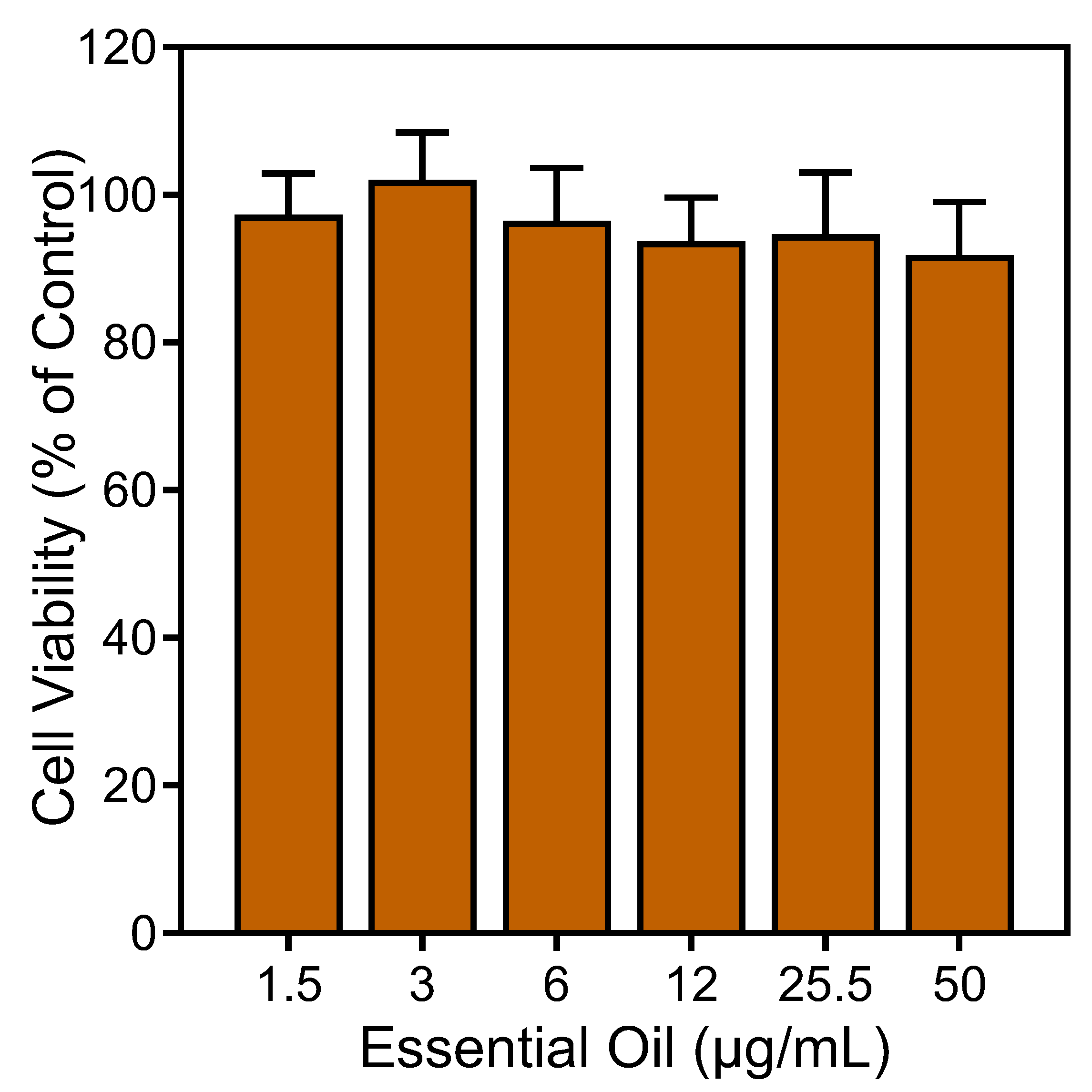
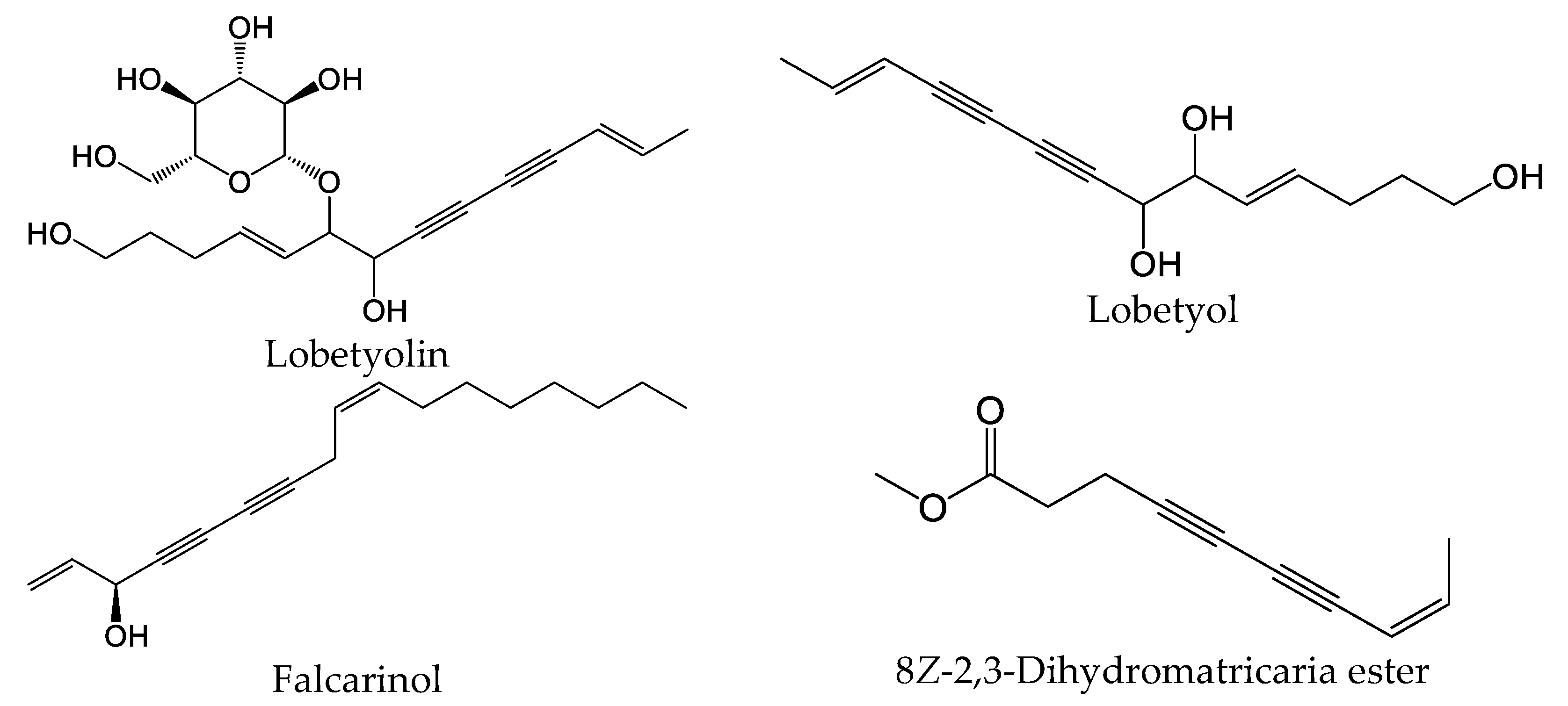
| No | RRI a | RRI b | Compound | % c | No | RRI a | RRI b | Compound | % c |
|---|---|---|---|---|---|---|---|---|---|
| 1 | 1032 | 1008–1039 [28] | α-Pinene | t | 38 | 1729 | 1729 [29] | cis-1,2-Epoxy-terpin-4-ol | 0.2 |
| 2 | 1035 | 1012–1039 [28] | α-Thujene | t | 39 | 1733 | 1693–1740 [28] | Neryl acetate | 0.2 |
| 3 | 1048 | 1051 [30] | 2-Methyl-3-buten-2-ol | 0.3 | 40 | 1744 | 1687–1770 [28] | Phellandral | 0.4 |
| 4 | 1118 | 1085–1130 [28] | β-Pinene | 1.7 | 41 | 1748 | 1689–1748 [28] | Piperitone | 0.6 |
| 5 | 1132 | 1098–1140 [28] | Sabinene | 0.4 | 42 | 1751 | 1699–1751 [28] | Carvone | 0.5 |
| 6 | 1174 | 1140–1175 [28] | Myrcene | 0.1 | 43 | 1758 | 1668–1771 [28] | cis-Piperitol | 0.9 |
| 7 | 1176 | 1148–1186 [28] | α-Phellandrene | 0.1 | 44 | 1786 | 1743–1788 [28] | ar-Curcumene | t |
| 8 | 1195 | 1167–1197 [28] | Dehydro-1,8-cineole | t | 45 | 1802 | 1747–1805 [28] | Cumin aldehyde | 0.9 |
| 9 | 1203 | 1178–1219 [28] | Limonene | 1.4 | 46 | 1811 | 1814 [31] | p-Mentha-1,3-dien-7-al | 0.3 |
| 10 | 1218 | 1188–1233 [28] | β-Phellandrene | 3.0 | 47 | 1864 | 1813–1865 [31] | p-Cymen-8-ol | 2.2 |
| 11 | 1246 | 1211–1251 [28] | (Z)-β-Ocimene | 1.4 | 48 | 1912 | 1912 [25] | cis-Dihydrocarveol | 0.4 |
| 12 | 1255 | 1222–1266 [28] | γ-Terpinene | 0.1 | 49 | 1969 | 1914–1977 [25] | cis-Jasmone | 0.8 |
| 13 | 1266 | 1232–1267 [28] | (E)-β-Ocimene | 0.4 | 50 | 1981 | 1969 [32] | (Z)-Methyl cinnamate | t |
| 14 | 1280 | 1246–1291 [28] | p-Cymene | 0.8 | 51 | 1981 | 1981 [33] | Cuminyl acetate | t |
| 15 | 1290 | 1261–1300 [28] | Terpinolene | 0.5 | 52 | 2023 | 2065 [34] | p-Mentha-1,4-dien-7-ol * | 0.9 |
| 16 | 1413 | 1413 [35] | Rose furan | 0.4 | 53 | 2030 | 1961–2033 [28] | Methyl eugenol | 0.2 |
| 17 | 1437 | 1385–1441[28] | α-Thujone | 0.5 | 54 | 2039 | - | 1-Hydroxy-pseudodiosphenol | 1.3 |
| 18 | 1443 | 1452 [36] | 2,5- Dimethylstyrene | 0.1 | 55 | 2050 | 1995–2055 [28] | (E)-Nerolidol | 0.4 |
| 19 | 1474 | 1425–1478 [28] | cis-Sabinene hydrate | 0.4 | 56 | 2071 | 2003–2071 [28] | Humulene epoxide-II | 0.1 |
| 20 | 1477 | 1477 [35] | 4,8-Epoxyterpinolene | 0.2 | 57 | 2096 | 2046–2105 [28] | (E)-Methyl cinnamate | 6.0 |
| 21 | 1483 | 1483 [37] | Octyl acetate | 0.1 | 58 | 2098 | 2049–2104 [28] | Globulol | 0.3 |
| 22 | 1487 | 1487 [38] | Isoneroloxide | t | 59 | 2113 | 2070–2114 [28] | Cumin alcohol | 1.5 |
| 23 | 1498 | – | (E)-β-Ocimene epoxide | 0.1 | 60 | 2115 | 2115 [39] | 4-Hydroxy-4-methyl-cyclohex-2-enone | 0.8 |
| 24 | 1529 | 1529 [40] | Dill ether | t | 61 | 2144 | 2074–2150 [28] | Spathulenol | 3.6 |
| 25 | 1541 | 1481–1555 [28] | Benzaldehyde | 0.2 | 62 | 2170 | 2090–2189 [28] | β-Bisabolol | 1.1 |
| 26 | 1556 | 1526–1565 [28] | trans-Sabinene hydrate | 0.5 | 63 | 2183 | 2090–2178 [28] | γ-Decalactone | 13.3 |
| 27 | 1571 | 1557–1625 [28] | trans-p-Menth-2-en-1-ol | 2.1 | 64 | 2187 | 2184 [41] | T-Cadinol | 4.7 |
| 28 | 1611 | 1564–1630 [28] | Terpinen-4-ol | 9.3 | 65 | 2209 | 2200 [42] | T-Muurolol | 0.8 |
| 29 | 1626 | 1626 [43] | 2-Methyl-6-methylene-3,7-octadien-2-ol | t | 66 | 2214 | 2214 [25] | ar-Turmerol | 0.4 |
| 30 | 1638 | 1555–1645 [28] | cis-p-Menth-2-en-1-ol | 2.0 | 67 | 2241 | p-Isopropyl phenol | 0.3 | |
| 31 | 1648 | 1597–1648 [28] | Myrtenal | t | 68 | 2249 | 2227 [44] | 8Z-2,3-Dihydromatricaria ester | 3.1 |
| 32 | 1655 | 1670 [45] | Chrysanthenyl isobutyrate | 1 | 69 | 2255 | 2180–2255 [28] | α-Cadinol | 1.6 |
| 33 | 1662 | 1626–1663 [28] | Pulegone | 0.1 | 70 | 2272 | - | 4-Hydroxycryptone | 0.5 |
| 34 | 1678 | 1620–1678 [28] | cis-p-Mentha-2,8-dien-1-ol | 0.2 | 71 | 2309 | 2336 [44] | (2Z,8Z)-Matricaria ester | t |
| 35 | 1690 | 1644–1690 [28] | Cryptone | 9.4 | 72 | 2368 | 2368 [46] | Eudesma-4(15),7-diene-1-b-ol | 0.2 |
| 36 | 1700 | 1662–1717 [28] | p-Mentha-1,8-dien-4-ol | 0.8 | 73 | 2396 | 2396 [47] | γ-Dodecalactone | 1.7 |
| 37 | 1706 | 1659–1724 [28] | α-Terpineol | 1.9 | 74 | 2430 | - | 3-Ethoxy-2-cycloocten-1-one * | 2.2 |
| Number of Compounds | Class | % |
|---|---|---|
| 13 | Monoterpene hydrocarbons | 10.0 |
| 34 | Oxygenated monoterpenes | 37.7 |
| 1 | Sesquiterpene hydrocarbons | t |
| 11 | Oxygenated sesquiterpenes | 14.7 |
| 2 | Lactones | 15.0 |
| 2 | Acetylenic derivatives | 3.1 |
| 2 | Benzenoid aromatics | 6.0 |
| 9 | Others | 5.4 |
Disclaimer/Publisher’s Note: The statements, opinions and data contained in all publications are solely those of the individual author(s) and contributor(s) and not of MDPI and/or the editor(s). MDPI and/or the editor(s) disclaim responsibility for any injury to people or property resulting from any ideas, methods, instructions or products referred to in the content. |
© 2024 by the authors. Licensee MDPI, Basel, Switzerland. This article is an open access article distributed under the terms and conditions of the Creative Commons Attribution (CC BY) license (https://creativecommons.org/licenses/by/4.0/).
Share and Cite
Schepetkin, I.A.; Özek, G.; Özek, T.; Kirpotina, L.N.; Khlebnikov, A.I.; Ayçiçek, K.; Lavin, M.; Quinn, M.T. Phytochemical Composition and Biological Activity of the Essential Oil from Ericameria nauseosa Collected in Southwestern Montana, United States. Plants 2024, 13, 2063. https://doi.org/10.3390/plants13152063
Schepetkin IA, Özek G, Özek T, Kirpotina LN, Khlebnikov AI, Ayçiçek K, Lavin M, Quinn MT. Phytochemical Composition and Biological Activity of the Essential Oil from Ericameria nauseosa Collected in Southwestern Montana, United States. Plants. 2024; 13(15):2063. https://doi.org/10.3390/plants13152063
Chicago/Turabian StyleSchepetkin, Igor A., Gulmira Özek, Temel Özek, Liliya N. Kirpotina, Andrei I. Khlebnikov, Kevser Ayçiçek, Matthew Lavin, and Mark T. Quinn. 2024. "Phytochemical Composition and Biological Activity of the Essential Oil from Ericameria nauseosa Collected in Southwestern Montana, United States" Plants 13, no. 15: 2063. https://doi.org/10.3390/plants13152063









